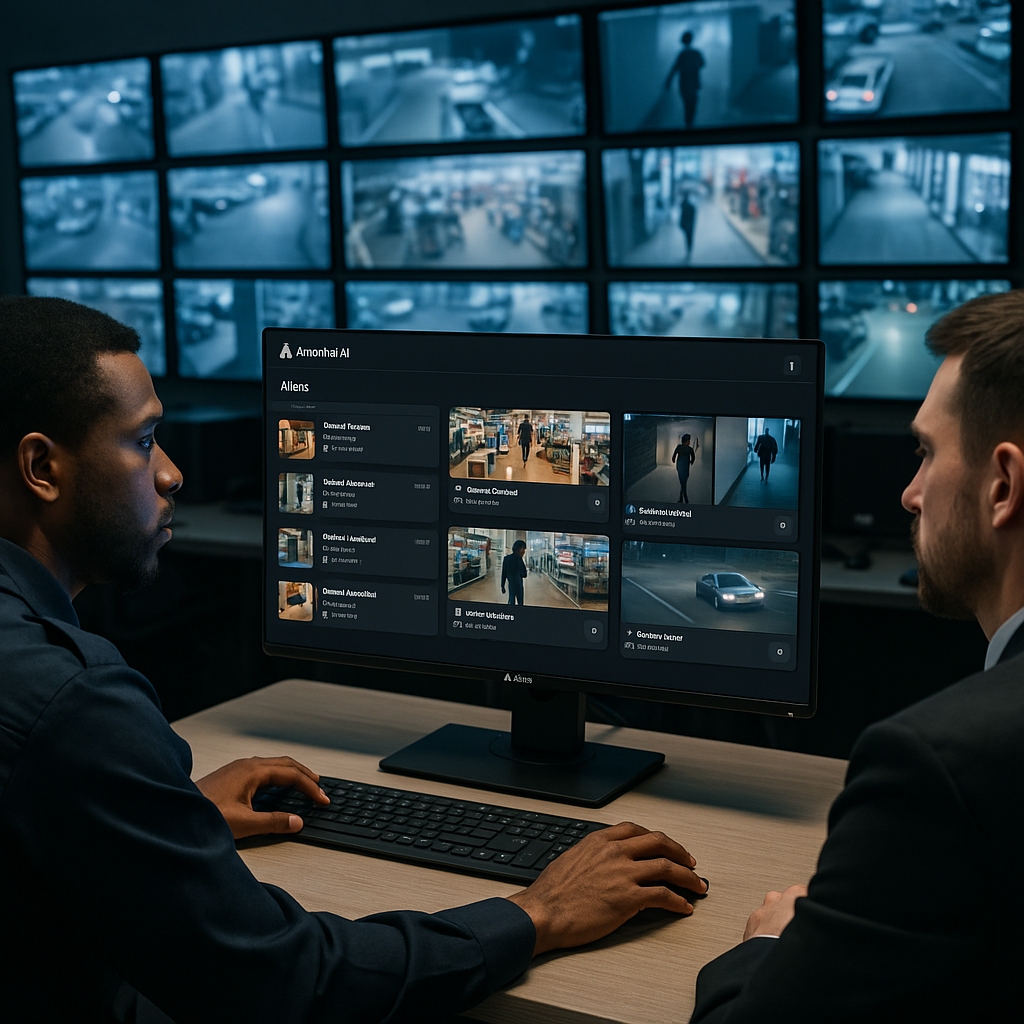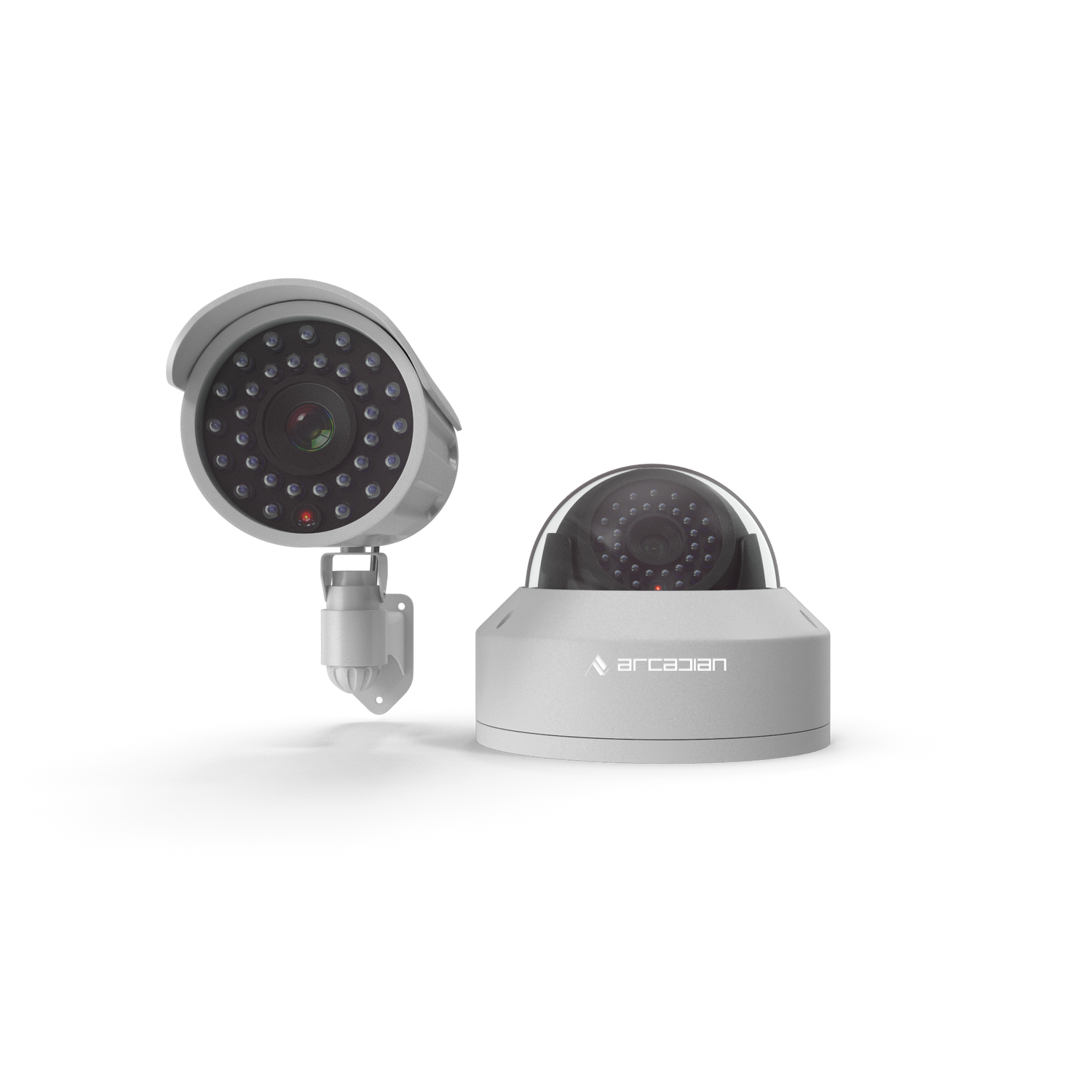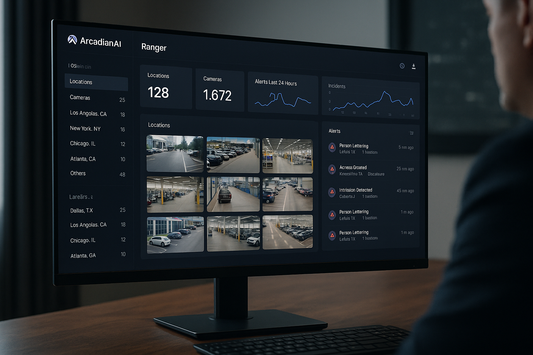Cloud Providers in Video Surveillance: A Comprehensive Technical Comparison of AWS, Azure, GCP, OCI, Alibaba, Huawei & More
Selecting the ideal cloud for video surveillance involves more than storage—it’s about AI-driven analytics, cost-efficient scaling, and NDAA compliance. Dive into our detailed comparison of top cloud providers and see how ArcadianAI optimizes them all.

Introduction
With over 1 billion surveillance cameras worldwide generating petabytes of data daily, cloud-based video surveillance (VSaaS) is transforming security for smart cities, retail chains, critical infrastructure, and more. The global video surveillance market is expected to hit $83 billion by 2030, fueled by AI analytics, 5G connectivity, and the shift from on-premises NVRs to scalable cloud platforms. However, not all clouds are built to handle the unique demands of video workloads: high-bandwidth ingestion, sub-second AI processing, and cost-effective retention.
This guide provides a detailed technical comparison of the leading cloud providers—Amazon Web Services (AWS), Microsoft Azure, Google Cloud Platform (GCP), Oracle Cloud Infrastructure (OCI), Alibaba Cloud, and Huawei Cloud—for video surveillance. We evaluate their performance, pricing, SLAs, scalability, and AI capabilities, with a focus on NDAA compliance for North American deployments. Additionally, we spotlight ArcadianAI, a camera-agnostic, AI-first surveillance layer that enhances any cloud provider, optimizing costs and intelligence for multi-site operations.
Key Takeaways:
- AWS dominates with unmatched scalability but faces high egress costs.
- Azure excels in enterprise integrations and NDAA-compliant deployments.
- GCP leads in AI-driven video analytics with prebuilt ML models.
- OCI offers budget-friendly pricing and high-performance storage.
- Alibaba and Huawei dominate APAC but face NDAA restrictions in North America.
- ArcadianAI’s Ranger AI assistant unifies multi-cloud environments, reducing costs and false positives.
Background & Relevance
Video surveillance has evolved from passive recording to proactive intelligence, driven by AI, edge computing, and cloud scalability. Traditional NVRs struggle with thousands of cameras or petabytes of footage, while cloud platforms offer:
- Scalable ingestion: Handle millions of streams in real-time.
- Distributed AI: Process events at the edge or in the cloud.
- Long-term retention: Archive footage cost-effectively.
- Global access: Monitor multi-site operations from anywhere.
However, cloud video surveillance faces unique challenges:
- Storage explosion: A single 4K camera at 30 FPS generates ~1TB/month.
- Latency sensitivity: Real-time alerts require <500ms processing.
- Bandwidth bottlenecks: Uploading 24/7 video strains networks.
- Cost unpredictability: Egress, compute, and AI inference fees add up.
- Compliance: NDAA bans restrict certain providers in the US/Canada.
Choosing the right cloud provider—and a smart surveillance layer like ArcadianAI—addresses these pain points, ensuring performance, compliance, and cost efficiency.
Core Topic Exploration
AWS (Amazon Web Services)
AWS, with a 31% cloud market share in Q3 2024, offers the most mature ecosystem for video surveillance. Amazon S3 (Standard, Glacier) supports tiered storage, while Kinesis Video Streams enables real-time ingestion. AWS Rekognition delivers AI analytics for facial recognition, license plate detection, and behavior analysis. CloudFront’s global CDN reduces latency for live streaming, and AWS Greengrass supports edge compute for hybrid deployments.
- SLA: 99.99% for S3; 99.95% for Kinesis Video Streams.
- Pricing: $0.023/GB/month (S3 Standard); $0.09/GB egress; spot instances up to 90% savings.
- Surveillance Partners: Milestone Systems, BriefCam, Verkada, Amazon Ring.
- AI Capabilities: Rekognition, SageMaker for custom ML models.
- Strengths: Extensive AI stack, serverless Lambda for event-driven processing, global infrastructure (105 Availability Zones).
- Challenges: High egress costs, complex pricing models, steep learning curve for optimization.
- NDAA Compliance: Fully compliant, widely used in US government deployments.
Use Case: Global retail chains use AWS for centralized video management, leveraging Rekognition for shoplifting detection and S3 for 90-day retention.
Microsoft Azure
Azure, holding a 20% market share, is a favorite for enterprise and compliance-driven surveillance. Azure Blob Storage (Hot, Cool, Archive tiers) supports scalable archiving, while Azure Live Video Analytics and Cognitive Services provide robust AI for object detection and anomaly alerts. Native integrations with Genetec Security Center make Azure ideal for enterprise security. Azure’s compliance with FedRAMP, HIPAA, and NDAA ensures suitability for regulated sectors.
- SLA: 99.9% for Blob Storage; 99.95% for Cognitive Services.
- Pricing: $0.0184/GB/month (Cool tier); egress ~$0.05/GB with enterprise agreements.
- Surveillance Partners: Genetec, Rhombus Systems, Avigilon.
- AI Capabilities: Cognitive Services, Azure Machine Learning.
- Strengths: Seamless Microsoft ecosystem integration, strong compliance portfolio, hybrid cloud support via Azure Arc.
- Challenges: Limited edge GPU support, less mature video ingestion APIs than AWS.
- NDAA Compliance: Fully compliant, trusted by US public sector clients.
Use Case: Hospitals use Azure for secure, HIPAA-compliant video monitoring, integrating with Genetec for real-time patient safety alerts.
Google Cloud Platform (GCP)
GCP, with an 11% market share, excels in AI-driven video surveillance. Its Video Intelligence API auto-tags footage, detecting motion, objects, and activities with prebuilt ML models. Google’s global backbone network ensures low-latency ingestion, while Cloud Storage and BigQuery support scalable archiving and analytics. GCP’s TensorFlow ecosystem enables custom AI development.
- SLA: 99.9% for Cloud Storage; 99.95% for AI services.
- Pricing: $0.020/GB/month (Standard); $0.08/GB egress; generous AI free tier.
- Surveillance Partners: VIVOTEK, Hanwha Techwin, custom integrations.
- AI Capabilities: Video Intelligence API, Vertex AI, AutoML.
- Strengths: Best-in-class video AI, global CDN, cost-efficient for analytics-heavy workloads.
- Challenges: Limited enterprise support in regulated industries, fewer surveillance integrations.
- NDAA Compliance: Fully compliant, suitable for North American deployments.
Use Case: Smart cities leverage GCP’s Video Intelligence API for traffic monitoring, analyzing footage in real-time to optimize urban flow.
Oracle Cloud Infrastructure (OCI)
OCI, a fast-growing contender, emphasizes price-performance for surveillance. Its NVMe-backed block storage and GPU burst compute handle high-throughput video processing, while Object Storage offers low-cost archiving. OCI Vision provides emerging AI capabilities for object and scene detection.
- SLA: 99.99% for Object Storage and Compute.
- Pricing: $0.0255/GB/month (Object Storage); $0.0055/GB egress.
- Surveillance Use Cases: Government, banking, APAC enterprises.
- AI Capabilities: OCI Vision, Data Science platform.
- Strengths: Predictable pricing, fast storage, sovereign cloud options for data residency.
- Challenges: Limited surveillance-specific integrations, nascent AI ecosystem.
- NDAA Compliance: Fully compliant, gaining traction in US government projects.
Use Case: Regional banks use OCI for cost-effective video storage and compliance with local data sovereignty laws.
Alibaba Cloud
Alibaba Cloud, with a 5% global market share, dominates surveillance in China and Southeast Asia. Its Video AI Service (VIS) supports facial recognition, behavior analysis, and RTMP streaming. Object Storage Service (OSS) offers low-cost hot/cold tiers, and Alibaba’s massive CDN ensures low-latency delivery.
- SLA: 99.9% for OSS and VIS.
- Pricing: ~$0.015/GB/month (OSS Standard); ~$0.02/GB egress.
- Surveillance Use Cases: Smart cities, retail, government in APAC.
- AI Capabilities: VIS, SenseTime integrations.
- Strengths: Cost-effective storage, extensive APAC CDN, local compliance expertise.
- Challenges: Limited global support, NDAA non-compliance restricts North American use.
- NDAA Compliance: Not compliant, banned in US/Canada due to data sovereignty concerns.
Use Case: Southeast Asian malls use Alibaba Cloud for crowd monitoring, leveraging VIS for real-time occupancy analytics.
Huawei Cloud
Huawei Cloud’s Enterprise Intelligence (EI) stack includes advanced video analytics for object detection, scene analysis, and behavior prediction. Popular in state-driven surveillance across Asia, Africa, and the Middle East, Huawei offers low-cost storage and high-performance AI inferencing.
- SLA: 99.95% for EI and storage services.
- Pricing: ~$0.014/GB/month; ~$0.01/GB egress.
- Surveillance Use Cases: Government, public safety, transportation.
- AI Capabilities: EI stack, ModelArts for custom ML.
- Strengths: Optimized for large-scale surveillance, cost-efficient AI processing.
- Challenges: NDAA non-compliance, geopolitical restrictions in Western markets.
- NDAA Compliance: Not compliant, restricted in US/Canada.
Use Case: Middle Eastern governments deploy Huawei Cloud for city-wide surveillance, integrating EI for predictive policing.
ArcadianAI: The Cloud-Agnostic Intelligence Layer
ArcadianAI isn’t a cloud provider but a surveillance platform that enhances any cloud. Its Ranger AI assistant preprocesses events on-prem or at the edge, reducing cloud compute and egress costs. ArcadianAI integrates with AWS, Azure, GCP, OCI, and more, offering a unified dashboard for multi-cloud environments.
- Architecture: Hybrid (on-prem bridge + cloud core).
- Retention: Compatible with any storage tier (S3, Blob, GCS, OSS).
- AI Capabilities: Custom frame scoring, OpenVINO, YOLO, GPT-V integrations.
- Use Cases: Retail loss prevention, forensic search, compliance audits, time-based reviews.
- Pricing: Flat per-camera license, no per-GB fees.
- NDAA Compliance: Fully compliant, ideal for North American deployments.
Use Case: Multi-site retailers use ArcadianAI to unify AWS and Azure feeds, reducing false alarms by 80% with Ranger AI.
Comparisons & Use Cases
| Cloud Provider | Best For | AI Capabilities | Storage Cost (1TB) | Egress (per GB) | SLA | NDAA Compliant |
|---|---|---|---|---|---|---|
| AWS | Scalability | Rekognition, SageMaker | ~$23 | $0.09 | 99.99% | ✅ |
| Azure | Enterprise | Cognitive Services | ~$18.40 | ~$0.05 (EA) | 99.9% | ✅ |
| GCP | AI Analytics | Video Intelligence API | ~$20 | $0.08 | 99.9% | ✅ |
| OCI | Budget | OCI Vision | ~$25.50 | $0.0055 | 99.99% | ✅ |
| Alibaba | APAC Deployments | Video AI Service | ~$15 | ~$0.02 | 99.9% | ❌ |
| Huawei | Government | EI Stack | ~$14 | ~$0.01 | 99.95% | ❌ |
| ArcadianAI | Multi-Cloud | Ranger + Custom AI | Cloud-agnostic | Zero egress | N/A | ✅ |
Use Case Breakdown:
- Global Retail: AWS + ArcadianAI for scale and cost optimization.
- Healthcare: Azure for HIPAA compliance and Genetec integration.
- Smart Cities: GCP for AI-driven traffic and crowd analytics.
- Budget-Conscious: OCI for low-cost storage and predictable pricing.
- APAC Government: Alibaba or Huawei for local compliance and cost.
- Multi-Site Hybrid: ArcadianAI across AWS/Azure for unified intelligence.
Common Questions (FAQ)
Q: Which cloud provider is best for multi-site video surveillance?
AWS and Azure offer the most robust global infrastructure, but ArcadianAI provides a unified layer across multiple clouds, simplifying management.
Q: How can I reduce cloud costs for video surveillance?
Leverage ArcadianAI’s edge preprocessing to minimize cloud compute, use tiered storage (e.g., S3 Glacier, Azure Archive), and opt for spot instances or reserved capacity.
Q: Is GCP superior for AI-based video tagging?
Yes, GCP’s Video Intelligence API outperforms competitors in general-purpose tagging and motion detection, thanks to its TensorFlow-backed models.
Q: Can I use multiple cloud providers for surveillance?
Absolutely. ArcadianAI supports hybrid and multi-cloud setups, blending AWS compute with Azure storage or GCP analytics for optimal performance.
Q: Are Alibaba and Huawei NDAA-compliant for North America?
No. Both are banned under NDAA Section 889 due to national security concerns, restricting their use in US/Canada government and critical infrastructure projects.
Q: What is NDAA compliance, and why does it matter?
The National Defense Authorization Act (NDAA) prohibits certain Chinese-manufactured equipment (e.g., Huawei, Hikvision) in US federal systems. NDAA-compliant clouds like AWS, Azure, GCP, and OCI are mandatory for US government and contractor deployments.

Conclusion & Call-to-Action
Cloud video surveillance is a high-stakes workload requiring scalability, low latency, and intelligent analytics. AWS leads in ecosystem depth, Azure in enterprise compliance, GCP in AI innovation, OCI in cost efficiency, and Alibaba/Huawei in APAC dominance—but each has trade-offs. ArcadianAI’s cloud-agnostic platform, powered by Ranger AI, unifies these providers, delivering cost savings, compliance, and actionable intelligence.
Ready to transform your surveillance strategy? Explore ArcadianAI’s multi-cloud solution and see how it optimizes AWS, Azure, GCP, and more.
References:

Security is like insurance—until you need it, you don’t think about it.
But when something goes wrong? Break-ins, theft, liability claims—suddenly, it’s all you think about.
ArcadianAI upgrades your security to the AI era—no new hardware, no sky-high costs, just smart protection that works.
→ Stop security incidents before they happen
→ Cut security costs without cutting corners
→ Run your business without the worry
Because the best security isn’t reactive—it’s proactive.







